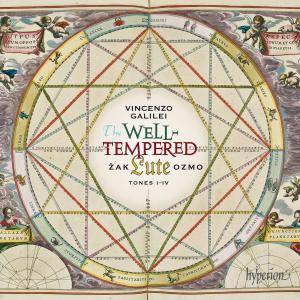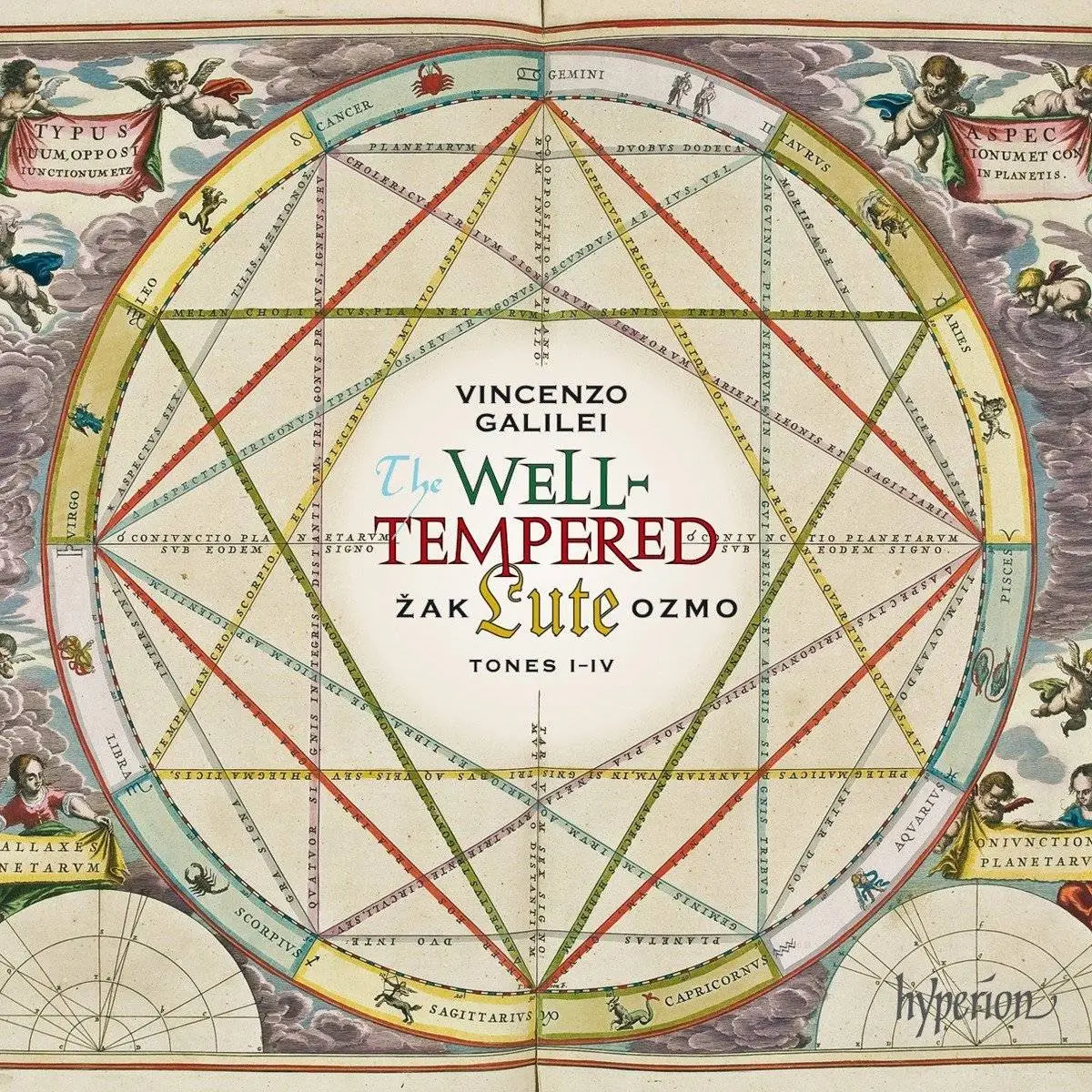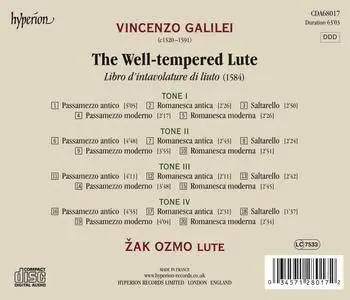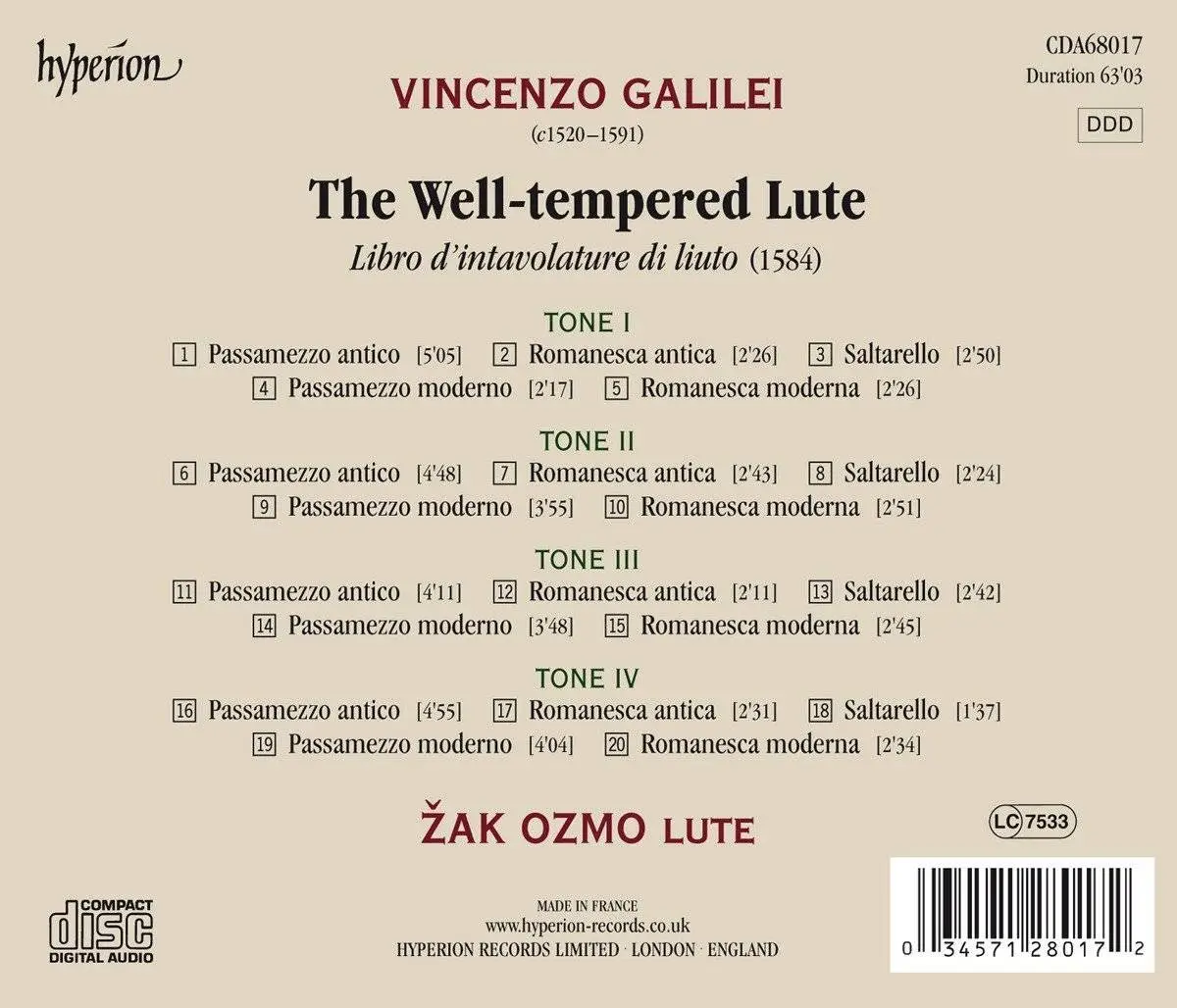Žak Ozmo - Vincenzo Galilei: The Well-tempered Lute - Libro d'intavolature di liuto (2016)
EAC | FLAC | Image (Cue&Log) ~ 247 Mb | Mp3 (CBR320) ~ 149 Mb | Scans included
Genre: Classical | Label: Hyperion | # CDA68017 | Time: 01:03:01
EAC | FLAC | Image (Cue&Log) ~ 247 Mb | Mp3 (CBR320) ~ 149 Mb | Scans included
Genre: Classical | Label: Hyperion | # CDA68017 | Time: 01:03:01
This recording of lute music may be of most interest to fans of the lute and of the Renaissance-Baroque transition era, but it will be of considerable interest to them: it marks the first recording of the Libro d'intavolature di liuto, or Book of Lute Tablatures, of Vincenzo Galilei (1584). Galilei was the father of none other than astronomer Galileo. The work is given the title The Well-Tempered Lute here; that was not Galilei's title, but the music was apparently the first collection intended to demonstrate the possibilities of equal temperament that Bach would exploit so dramatically a century and a half later. Some scholars have opined that this was a primarily theoretical work; as music, it is both technically difficult and a little monotonous, consisting of groups of dances that may or may not have been danced to. Lutenist Žak Ozmo makes a good case for these little pieces as performer's music, differentiating learned counterpoint from works of a more expressive character. His booklet notes lay out the issues involved in bringing this music to life, and explain the role Galilei played in the group of Florentine musical intellectuals that gave birth to the Baroque. Perhaps the most attractive feature of the album is the sound, captured at Southampton's Holy Trinity Church. A church is not optimal for music like this, but Hyperion's engineers get impressive results; the lute almost seems to purr, and there is no extraneous sound. A recommended recording of music that might well have been known to the great lute composers of the early Baroque.Review by James Manheim, Allmusic.com
The collective members of the Galilei family seem to have embodied the principles of Renaissance polymathic curiosity and endeavour. Best known of the clan is the physicist and astronomer Galileo Galilei, whose controversial championing of heliocentrism and Copernicanism aroused the ire of Pope and Inquisition and led to recantation and house arrest. Galileo was no mean lutenist, and his brother Michelangelo also became a noted lutenist and composer; perhaps their fascination with ‘measure’, musical and mathematical, was inherited from their father, Vincenzo Galilei. The latter was a renowned instrumentalist, composer and theorist, whose intellectual and musical talents had been recognised by his teacher, the Florentine Giovanni de’Bardi, who sent his protégé to study with the theorist Gioseffo Zarlino. Zarlino's ideas Vincenzo later challenged in the Dialogo della musica antica and della moderna of 1581.
Vincenzo later became a central figure among the humanists who formed the Florentine Camerata, but he remained a practising musician throughout his life, publishing, among other works, lute tabulations and two books of madrigals. His theoretic writings explored counterpoint, musica ficta, text setting, dissonance and tuning systems. In some ways, the Libro d’intavolature di liuto represents the fruition of his scholarship and experimentation.
The autograph manuscript, held in the Biblioteca nazionale centrale in Florence, is divided into three parts, the first two of which have two suites of passamezzo, romanesca and saltarello on each of the twelve ascending semitones of the equal-tempered octave. This recording by the Yugoslavian lutenist Žac Ozmo presents sets of passamezzo antico-romansesca antica-saltarello followed by the corresponding passamezzo moderno and romanesca moderna on the first four steps of the scale.
Are these theoretical experiments or expressive art works; can they be both? From the first item, the Passamezzo antico from Book 1 No 1, Ozmo shows us that intellectual perspicacity can blend with expressive articulacy. There is a careful precision about the placement of, for example, the spread chords, and the direction-giving bass line, but there are also moments of subtle rubato and delay; and the resonant acoustic of the recording helps to temper any innate ‘dry-ness’ in the musical material.
The sound is occasionally a little hard-edged but this allows us to appreciate Ozmo’s technical accuracy. While this disc might appeal most strongly to the lute aficionado there is no lack of communicative variety; nothing to alienate the new-comer. For example, there is a lovely withdrawal of sound in the Romanesca antica Book 1 No 2 which takes us from the Renaissance science laboratory to the poetic reveries of Nicholas Hilliard’s ‘Young Man among Roses’. On a simpler level, the contrast of duple-metre passamezzos and triple-metre romanescos, followed by the relative freedoms of the saltarello dances, provides its own range of varieties. The Passamezzo antico Book 1 No 7 acquires gradual impetus accompanied by expressive melodic and harmonic detail. There are some particularly lovely shifts between major and minor modes, as well as between homophony and counterpoint. The prominence of the upper registers in the Romanesca antica Book 1 No 8 are refreshing; and the sparse textures, yet gentle arguments, of the Saltarello Book 1 No 9 are similarly appealing.
More potently, the shift from one degree of the well-tempered scale to the next is wonderfully disconcerting: the Passamezzo antico Book 1 No 4 sounds positively cool and cerebral, and the more animated tempo only increases the intensity. The scalic running motifs seemed designed to prompt intellectual debate, as confirmed by the stolid stepwise approaches to cadences. The tierce de Picardie lifts and brightens, but is quelled by the subsequent Romanesca antica which – with bold invention – after seeming to deny idiosyncrasy, then treats scalic motifs with a degree of freedom. An incipient anarchy is enhanced by the musical theatrics of the tuning. As Ozmo explains, his six-course lute in G tuning – the bottom open string being G – is tuned in equal temperament as advocated by Galilei, with gut strings employed for the fifth and sixth course. This results in clarity of line and less interference from the sustaining bass, but also produces slight fluctuations in tuning – which are most piquantly experienced here.
Indeed, this disc invites us constantly to reassess and realign our expectations. The Romanesca antica of Tone II is good example of how ‘clinical’ openings can flourish into melodic then ornamental riches. Similarly, the Passamezzo antico Book 1 No 10 delights in lovely dialogues across registers. The tempi may be prevailingly moderate, but these are justified by the assertion in the Dialogo that ‘the lute and the viola d’arco’ are particularly suited to expressing the grave and serious, ‘like the Dorian mode’. The saltarellos provide lightness – although they are not without their intricacies and rhythmic complexities; Book 1 No 3 indulges in fantasia-like episodes towards the final cadence.
There are obviously considerable technical challenges of which Ozmo’s meticulous execution seems to make light. For example, he describes the need to keep the index finger of left hand flat on the fingerboard almost continuously while other fingers dance intricately, which requires great strength and agility.
In his engaging liner-notes Ozmo writes of his revelation when discovering the lute in his late teenage years and of his subsequent realisation, and wonder, that art and science can provide consolation and enrichment during times of personal and national adversity: ‘After all, if human beings are capable of creating beauty as reflected in the arts and mathematics, there must still be hope for us all even in the midst of the most terrible darkness’. Wise words, which we might do well to note.
This recording reveals both the science behind the scale; and the human expression behind the experiment.Review by Claire Seymour, MusicWeb-International.com
Tracklist:
01. Tone I - Book 1 No.1 - Passamezzo antico (05:05)
02. Tone I - Book 1 No.2 - Romanesca antica (02:25)
03. Tone I - Book 1 No.3 - Saltarello (02:49)
04. Tone I - Book 2 No.1 - Passamezzo moderno (02:16)
05. Tone I - Book 2 No.2 - Romanesca moderna (02:26)
06. Tone II - Book 1 No.4 - Passamezzo antico (04:47)
07. Tone II - Book 1 No.5 - Romanesca antica (02:43)
08. Tone II - Book 1 No.6 - Saltarello (02:23)
09. Tone II - Book 2 No.3 - Passamezzo moderno (03:54)
10. Tone II - Book 2 No.4 - Romanesca moderna (02:51)
11. Tone III - Book 1 No.7 - Passamezzo antico (04:10)
12. Tone III - Book 1 No.8 - Romanesca antica (02:10)
13. Tone III - Book 1 No.9 - Saltarello (02:41)
14. Tone III - Book 2 No.5 - Passamezzo moderno (03:48)
15. Tone III - Book 2 No.6 - Romanesca moderna (02:45)
16. Tone IV - Book 1 No.10 - Passamezzo antico (04:54)
17. Tone IV - Book 1 No.11 - Romanesca antica (02:31)
18. Tone IV - Book 1 No.12 - Saltarello (01:37)
19. Tone IV - Book 2 No.7 - Passamezzo moderno (04:03)
20. Tone IV - Book 2 No.8 - Romanesca moderna (02:33)
Exact Audio Copy V1.1 from 23. June 2015
EAC extraction logfile from 18. June 2016, 18:06
Zak Ozmo / Galilei - Libro d'intavolature di liuto
Used drive : HL-DT-STDVDRAM GU70N Adapter: 1 ID: 0
Read mode : Secure
Utilize accurate stream : Yes
Defeat audio cache : Yes
Make use of C2 pointers : No
Read offset correction : 48
Overread into Lead-In and Lead-Out : No
Fill up missing offset samples with silence : Yes
Delete leading and trailing silent blocks : No
Null samples used in CRC calculations : Yes
Used interface : Native Win32 interface for Win NT & 2000
Used output format : User Defined Encoder
Selected bitrate : 128 kBit/s
Quality : High
Add ID3 tag : No
Command line compressor : C:\Program Files (x86)\Exact Audio Copy\Flac\flac.exe
Additional command line options : -V -8 -T "Date=%year%" -T "Genre=%genre%" %source%
TOC of the extracted CD
Track | Start | Length | Start sector | End sector
––––––––––––––––––––––––––––-
1 | 0:00.00 | 5:05.31 | 0 | 22905
2 | 5:05.31 | 2:25.61 | 22906 | 33841
3 | 7:31.17 | 2:49.48 | 33842 | 46564
4 | 10:20.65 | 2:16.51 | 46565 | 56815
5 | 12:37.41 | 2:26.23 | 56816 | 67788
6 | 15:03.64 | 4:47.64 | 67789 | 89377
7 | 19:51.53 | 2:43.23 | 89378 | 101625
8 | 22:35.01 | 2:23.70 | 101626 | 112420
9 | 24:58.71 | 3:54.69 | 112421 | 130039
10 | 28:53.65 | 2:51.05 | 130040 | 142869
11 | 31:44.70 | 4:10.68 | 142870 | 161687
12 | 35:55.63 | 2:10.71 | 161688 | 171508
13 | 38:06.59 | 2:41.60 | 171509 | 183643
14 | 40:48.44 | 3:48.01 | 183644 | 200744
15 | 44:36.45 | 2:45.05 | 200745 | 213124
16 | 47:21.50 | 4:54.47 | 213125 | 235221
17 | 52:16.22 | 2:31.01 | 235222 | 246547
18 | 54:47.23 | 1:37.20 | 246548 | 253842
19 | 56:24.43 | 4:03.39 | 253843 | 272106
20 | 60:28.07 | 2:33.53 | 272107 | 283634
Range status and errors
Selected range
Filename C:\temp\CDA68017 - Galilei - The Well-tempered Lute\Galilei - Libro d'intavolature di liuto.wav
Peak level 87.6 %
Extraction speed 5.0 X
Range quality 99.9 %
Test CRC C5B5A109
Copy CRC C5B5A109
Copy OK
No errors occurred
AccurateRip summary
Track 1 accurately ripped (confidence 2) [59B4216A] (AR v2)
Track 2 accurately ripped (confidence 2) [6925FD8B] (AR v2)
Track 3 accurately ripped (confidence 2) [908D7370] (AR v2)
Track 4 accurately ripped (confidence 2) [1F23954D] (AR v2)
Track 5 accurately ripped (confidence 2) [350C62AC] (AR v2)
Track 6 accurately ripped (confidence 2) [89663ED3] (AR v2)
Track 7 accurately ripped (confidence 2) [67E02311] (AR v2)
Track 8 accurately ripped (confidence 2) [91986FED] (AR v2)
Track 9 accurately ripped (confidence 2) [ECB22C2C] (AR v2)
Track 10 accurately ripped (confidence 2) [322D6C26] (AR v2)
Track 11 accurately ripped (confidence 2) [3558FF13] (AR v2)
Track 12 accurately ripped (confidence 2) [952C0093] (AR v2)
Track 13 accurately ripped (confidence 2) [BF415652] (AR v2)
Track 14 accurately ripped (confidence 2) [B384BC08] (AR v2)
Track 15 accurately ripped (confidence 2) [3BF3F51C] (AR v2)
Track 16 accurately ripped (confidence 2) [E7E31BE9] (AR v2)
Track 17 accurately ripped (confidence 2) [0EAA0F40] (AR v2)
Track 18 accurately ripped (confidence 2) [B408324D] (AR v2)
Track 19 accurately ripped (confidence 2) [843521A7] (AR v2)
Track 20 accurately ripped (confidence 2) [69148464] (AR v2)
All tracks accurately ripped
End of status report
==== Log checksum B3756DCD523CD6CF12D699524DC87A5129B8E99013A554B0C6354EEAA6AAC3E6 ====
EAC extraction logfile from 18. June 2016, 18:06
Zak Ozmo / Galilei - Libro d'intavolature di liuto
Used drive : HL-DT-STDVDRAM GU70N Adapter: 1 ID: 0
Read mode : Secure
Utilize accurate stream : Yes
Defeat audio cache : Yes
Make use of C2 pointers : No
Read offset correction : 48
Overread into Lead-In and Lead-Out : No
Fill up missing offset samples with silence : Yes
Delete leading and trailing silent blocks : No
Null samples used in CRC calculations : Yes
Used interface : Native Win32 interface for Win NT & 2000
Used output format : User Defined Encoder
Selected bitrate : 128 kBit/s
Quality : High
Add ID3 tag : No
Command line compressor : C:\Program Files (x86)\Exact Audio Copy\Flac\flac.exe
Additional command line options : -V -8 -T "Date=%year%" -T "Genre=%genre%" %source%
TOC of the extracted CD
Track | Start | Length | Start sector | End sector
––––––––––––––––––––––––––––-
1 | 0:00.00 | 5:05.31 | 0 | 22905
2 | 5:05.31 | 2:25.61 | 22906 | 33841
3 | 7:31.17 | 2:49.48 | 33842 | 46564
4 | 10:20.65 | 2:16.51 | 46565 | 56815
5 | 12:37.41 | 2:26.23 | 56816 | 67788
6 | 15:03.64 | 4:47.64 | 67789 | 89377
7 | 19:51.53 | 2:43.23 | 89378 | 101625
8 | 22:35.01 | 2:23.70 | 101626 | 112420
9 | 24:58.71 | 3:54.69 | 112421 | 130039
10 | 28:53.65 | 2:51.05 | 130040 | 142869
11 | 31:44.70 | 4:10.68 | 142870 | 161687
12 | 35:55.63 | 2:10.71 | 161688 | 171508
13 | 38:06.59 | 2:41.60 | 171509 | 183643
14 | 40:48.44 | 3:48.01 | 183644 | 200744
15 | 44:36.45 | 2:45.05 | 200745 | 213124
16 | 47:21.50 | 4:54.47 | 213125 | 235221
17 | 52:16.22 | 2:31.01 | 235222 | 246547
18 | 54:47.23 | 1:37.20 | 246548 | 253842
19 | 56:24.43 | 4:03.39 | 253843 | 272106
20 | 60:28.07 | 2:33.53 | 272107 | 283634
Range status and errors
Selected range
Filename C:\temp\CDA68017 - Galilei - The Well-tempered Lute\Galilei - Libro d'intavolature di liuto.wav
Peak level 87.6 %
Extraction speed 5.0 X
Range quality 99.9 %
Test CRC C5B5A109
Copy CRC C5B5A109
Copy OK
No errors occurred
AccurateRip summary
Track 1 accurately ripped (confidence 2) [59B4216A] (AR v2)
Track 2 accurately ripped (confidence 2) [6925FD8B] (AR v2)
Track 3 accurately ripped (confidence 2) [908D7370] (AR v2)
Track 4 accurately ripped (confidence 2) [1F23954D] (AR v2)
Track 5 accurately ripped (confidence 2) [350C62AC] (AR v2)
Track 6 accurately ripped (confidence 2) [89663ED3] (AR v2)
Track 7 accurately ripped (confidence 2) [67E02311] (AR v2)
Track 8 accurately ripped (confidence 2) [91986FED] (AR v2)
Track 9 accurately ripped (confidence 2) [ECB22C2C] (AR v2)
Track 10 accurately ripped (confidence 2) [322D6C26] (AR v2)
Track 11 accurately ripped (confidence 2) [3558FF13] (AR v2)
Track 12 accurately ripped (confidence 2) [952C0093] (AR v2)
Track 13 accurately ripped (confidence 2) [BF415652] (AR v2)
Track 14 accurately ripped (confidence 2) [B384BC08] (AR v2)
Track 15 accurately ripped (confidence 2) [3BF3F51C] (AR v2)
Track 16 accurately ripped (confidence 2) [E7E31BE9] (AR v2)
Track 17 accurately ripped (confidence 2) [0EAA0F40] (AR v2)
Track 18 accurately ripped (confidence 2) [B408324D] (AR v2)
Track 19 accurately ripped (confidence 2) [843521A7] (AR v2)
Track 20 accurately ripped (confidence 2) [69148464] (AR v2)
All tracks accurately ripped
End of status report
==== Log checksum B3756DCD523CD6CF12D699524DC87A5129B8E99013A554B0C6354EEAA6AAC3E6 ====
foobar2000 1.2 / Dynamic Range Meter 1.1.1
log date: 2016-07-09 13:49:03
––––––––––––––––––––––––––––––––––––––––
Analyzed: Zak Ozmo / Galilei - Libro d'intavolature di liuto
––––––––––––––––––––––––––––––––––––––––
DR Peak RMS Duration Track
––––––––––––––––––––––––––––––––––––––––
DR16 -4.69 dB -24.12 dB 5:05 01-Tone I - Book 1 No.1 - Passamezzo antico
DR15 -1.14 dB -19.57 dB 2:26 02-Tone I - Book 1 No.2 - Romanesca antica
DR15 -1.33 dB -19.40 dB 2:50 03-Tone I - Book 1 No.3 - Saltarello
DR14 -4.86 dB -22.30 dB 2:17 04-Tone I - Book 2 No.1 - Passamezzo moderno
DR13 -7.57 dB -23.18 dB 2:26 05-Tone I - Book 2 No.2 - Romanesca moderna
DR15 -4.54 dB -23.86 dB 4:48 06-Tone II - Book 1 No.4 - Passamezzo antico
DR13 -4.52 dB -20.78 dB 2:43 07-Tone II - Book 1 No.5 - Romanesca antica
DR14 -5.83 dB -21.66 dB 2:24 08-Tone II - Book 1 No.6 - Saltarello
DR15 -5.49 dB -22.61 dB 3:55 09-Tone II - Book 2 No.3 - Passamezzo moderno
DR14 -2.79 dB -19.84 dB 2:51 10-Tone II - Book 2 No.4 - Romanesca moderna
DR15 -4.69 dB -22.41 dB 4:11 11-Tone III - Book 1 No.7 - Passamezzo antico
DR14 -4.51 dB -20.92 dB 2:11 12-Tone III - Book 1 No.8 - Romanesca antica
DR14 -2.16 dB -19.58 dB 2:42 13-Tone III - Book 1 No.9 - Saltarello
DR14 -5.35 dB -21.94 dB 3:48 14-Tone III - Book 2 No.5 - Passamezzo moderno
DR15 -1.20 dB -19.81 dB 2:45 15-Tone III - Book 2 No.6 - Romanesca moderna
DR13 -4.56 dB -20.91 dB 4:55 16-Tone IV - Book 1 No.10 - Passamezzo antico
DR13 -6.52 dB -22.48 dB 2:31 17-Tone IV - Book 1 No.11 - Romanesca antica
DR14 -4.34 dB -22.52 dB 1:37 18-Tone IV - Book 1 No.12 - Saltarello
DR13 -5.04 dB -21.58 dB 4:04 19-Tone IV - Book 2 No.7 - Passamezzo moderno
DR14 -6.91 dB -23.93 dB 2:34 20-Tone IV - Book 2 No.8 - Romanesca moderna
––––––––––––––––––––––––––––––––––––––––
Number of tracks: 20
Official DR value: DR14
Samplerate: 44100 Hz
Channels: 2
Bits per sample: 16
Bitrate: 536 kbps
Codec: FLAC
================================================================================
log date: 2016-07-09 13:49:03
––––––––––––––––––––––––––––––––––––––––
Analyzed: Zak Ozmo / Galilei - Libro d'intavolature di liuto
––––––––––––––––––––––––––––––––––––––––
DR Peak RMS Duration Track
––––––––––––––––––––––––––––––––––––––––
DR16 -4.69 dB -24.12 dB 5:05 01-Tone I - Book 1 No.1 - Passamezzo antico
DR15 -1.14 dB -19.57 dB 2:26 02-Tone I - Book 1 No.2 - Romanesca antica
DR15 -1.33 dB -19.40 dB 2:50 03-Tone I - Book 1 No.3 - Saltarello
DR14 -4.86 dB -22.30 dB 2:17 04-Tone I - Book 2 No.1 - Passamezzo moderno
DR13 -7.57 dB -23.18 dB 2:26 05-Tone I - Book 2 No.2 - Romanesca moderna
DR15 -4.54 dB -23.86 dB 4:48 06-Tone II - Book 1 No.4 - Passamezzo antico
DR13 -4.52 dB -20.78 dB 2:43 07-Tone II - Book 1 No.5 - Romanesca antica
DR14 -5.83 dB -21.66 dB 2:24 08-Tone II - Book 1 No.6 - Saltarello
DR15 -5.49 dB -22.61 dB 3:55 09-Tone II - Book 2 No.3 - Passamezzo moderno
DR14 -2.79 dB -19.84 dB 2:51 10-Tone II - Book 2 No.4 - Romanesca moderna
DR15 -4.69 dB -22.41 dB 4:11 11-Tone III - Book 1 No.7 - Passamezzo antico
DR14 -4.51 dB -20.92 dB 2:11 12-Tone III - Book 1 No.8 - Romanesca antica
DR14 -2.16 dB -19.58 dB 2:42 13-Tone III - Book 1 No.9 - Saltarello
DR14 -5.35 dB -21.94 dB 3:48 14-Tone III - Book 2 No.5 - Passamezzo moderno
DR15 -1.20 dB -19.81 dB 2:45 15-Tone III - Book 2 No.6 - Romanesca moderna
DR13 -4.56 dB -20.91 dB 4:55 16-Tone IV - Book 1 No.10 - Passamezzo antico
DR13 -6.52 dB -22.48 dB 2:31 17-Tone IV - Book 1 No.11 - Romanesca antica
DR14 -4.34 dB -22.52 dB 1:37 18-Tone IV - Book 1 No.12 - Saltarello
DR13 -5.04 dB -21.58 dB 4:04 19-Tone IV - Book 2 No.7 - Passamezzo moderno
DR14 -6.91 dB -23.93 dB 2:34 20-Tone IV - Book 2 No.8 - Romanesca moderna
––––––––––––––––––––––––––––––––––––––––
Number of tracks: 20
Official DR value: DR14
Samplerate: 44100 Hz
Channels: 2
Bits per sample: 16
Bitrate: 536 kbps
Codec: FLAC
================================================================================







